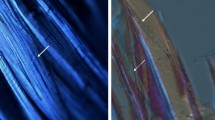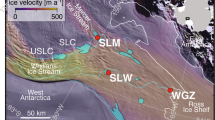Abstract
Organic matter in lake sediments is a mixture of biological materials from a number of modern sources plus variable amounts of recycled detrital material. Hence, it is usually difficult to distinguish input variations over time from the diagenesis of organic matter. Comparison of old material of known biological origin with younger material helps resolve this problem. We have compared the compositions of wood and needles from a modern white spruce (Picea glauca) with those from a white spruce buried for 10,000 yr in a lake bottom. Although the tissues are structurally well preserved, some chemical changes are evident in the old samples. Total fatty acid concentrations decrease by over 90%. Sterol and hydrocarbon concentrations are similar in the modern and 10,000-yr-old wood, but the concentration of sterols is lower in the old needles. Cellulose components in the wood have decreased relative to lignin components, although both types of materials remain in high concentration in comparison to other organic components.
This is a preview of subscription content, access via your institution
Access options
Subscribe to this journal
Receive 51 print issues and online access
$199.00 per year
only $3.90 per issue
Buy this article
- Purchase on Springer Link
- Instant access to full article PDF
Prices may be subject to local taxes which are calculated during checkout
Similar content being viewed by others
References
Dungworth, G., Schwartz, A. W. & van de Leemput, L. Comp. Biochem. Physiol. 53B, 473–480 (1976).
Gillispie, J. M. Science 170, 1100–1102 (1970).
Wehmiller, J. F., Hare, P. E. & Kujula, G. A. Geochim. cosmochim. Acta 40, 763–776 (1976).
King, K. Jr & Hare, P. E. Science 175, 1461–1463 (1972).
King, K. Jr Nature 252, 690–692 (1974).
Hohn, M. E. & Meinschein, W. G. Geochim. cosmochim. Acta 41, 189–193 (1977).
Dilcher, D. L., Pavlick, R. J. & Mitchell, J. Science 168, 1447–1449 (1970).
Giannasi, D. E. & Niklas, K. J. Science 197, 765–767 (1977).
Sigleo, A. C. Science 200, 1054–1056 (1978).
Traver, R. Am. Forests 86, 32–35, 51–54 (1980).
Farrington, J. W., Henrichs, S. M. & Anderson, R. Geochim. cosmochim. Acta 41, 289–296 (1977).
Meyers, P. A., Bourbonniere, R. A. & Takeuchi, N. Geochim. cosmochim. Acta 44, 1215–1221 (1980).
Lee, C., Gagosian, R. B. & Farrington, J. W. Geochim. cosmochim. Acta 41, 985–992 (1977).
Nishimura, M. & Koyama, T. Geochim. cosmochim. Acta 41, 379–385 (1977).
Nishimura, M. Nature 270, 711–712 (1977).
Bourbonniere, R. A. thesis, Univ. Michigan (1979).
Hedges, J. I. & Mann, D. C. Geochim. cosmochim. Acta 43, 1803–1807 (1979).
Author information
Authors and Affiliations
Rights and permissions
About this article
Cite this article
Meyers, P., Leenheer, M., Erstfeld, K. et al. Changes in spruce composition following burial in lake sediments for 10,000 yr. Nature 287, 534–536 (1980). https://doi.org/10.1038/287534a0
Received:
Accepted:
Issue Date:
DOI: https://doi.org/10.1038/287534a0
This article is cited by
-
Diagenesis of vascular plant organic matter components during burial in lake sediments
Aquatic Geochemistry (1995)
Comments
By submitting a comment you agree to abide by our Terms and Community Guidelines. If you find something abusive or that does not comply with our terms or guidelines please flag it as inappropriate.



